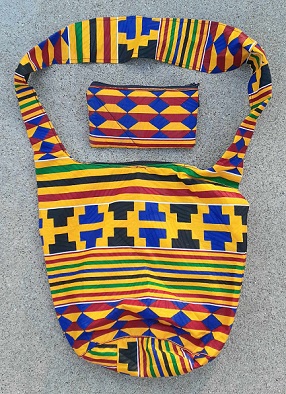Subject: warrior
Culture: Asante/Ashanti
Setting: Asante empire, 1806-1902
Object: costume
Batakari
* Spring 1993 p59
"Magical charms ... were widely used for protection in war before firearms became available. However, the obsolescence of shields and body armour was almost certainly matched, as at Benin, by an increased use of protective amulets and other charms among Asante soldiers. An added factor in Asante was the Muslim influence from the Northern territories. There, as in much of the western Sudan, war shirts, batakari, and cloth caps covered with amuletic charms sewn up in leather packets had been worn by soldiers and hunters for centuries before their use became widespread in Asante. The first mention of such war dress in Asante is by Thomas Bowdich who was a member of the British African Company's Mission sent to Kumase in 1817:
* Christoph/Müller/Ritz-Müller 1999 p407
"Einflüsse aus dem Norden weist auch die Kriegstracht aus, die batakari-Kittel und dei dazugehörigen Tuchkappen. Schon früher glaubten die Asante, wirksame magische Schutzmittel von möglichst weither, von Leuten am Rand ihrer Welt gewinnen zu künnen, und meinten, daß diese besonders zauberkundig seien. Von Muslimen bezog man etwa die gemeinhin in Leder- oder Tuchbeutel eingenähten, bei ranghohen Persönlichkeiten auch in Gold- oder Silberkapseln gefaßten Amulette, die am Kittel getragen werden. Sie sollten den Kriegern Unverletzlichkeit verleihen, das heißt die Arme der Feinde lähmen oder zittern machen, so daß ihre Kugelnishr Siel verfehlten. Die größten dieser Hemden (batakari kese, "großer batakari") besitzen nur der Asantehene, der das seine von seinem Vorfahren "Katakyie" Opoku Ware, ein Stück aus dem Jahr 1731, geerbt haben soll, und andere einflußreiche Machthaber. Jeder Asantehene muß zweimal im Leben den batakari kese anlegen: anläßlich des Inthronisationsrituals und während der ayi-kese genannten Zeremonie, die den Abschluß der Bestattungsfeierlichkeiten für seinen Vorgänger bildet. Im erstern Fall unterstreicht das Trachtstück seine Rolle als militärischer Führer, im zweiten die ungezähmte Gewalt, die beim Tod eines Herrschers frei wird."
Kente
* Blier 1998 p152-153
"The status and ritual associations of regalia are complemented in traditions of royal textiles, among these kente cloth. While the word kente is from the south, of neighboring Fante origin (from the word kenten, meaning basket), the term has been more generally associated with cloths from the Asante area which Fante traders disseminated along the coast. Despite kente's local associations, its technological roots appear to come from further north, in early textiles such as those found in sites near the Sahara in the eleventh century. Myths link the origins of kente to the trickster and wisdom-sybilizing spider Ananse (nature's weaver). The process of narrow-loom weaving was ritually marked: no cloth was initiated or terminated on Fridays and offerings were made to the looms after major transgressions.
Bag
*
"
